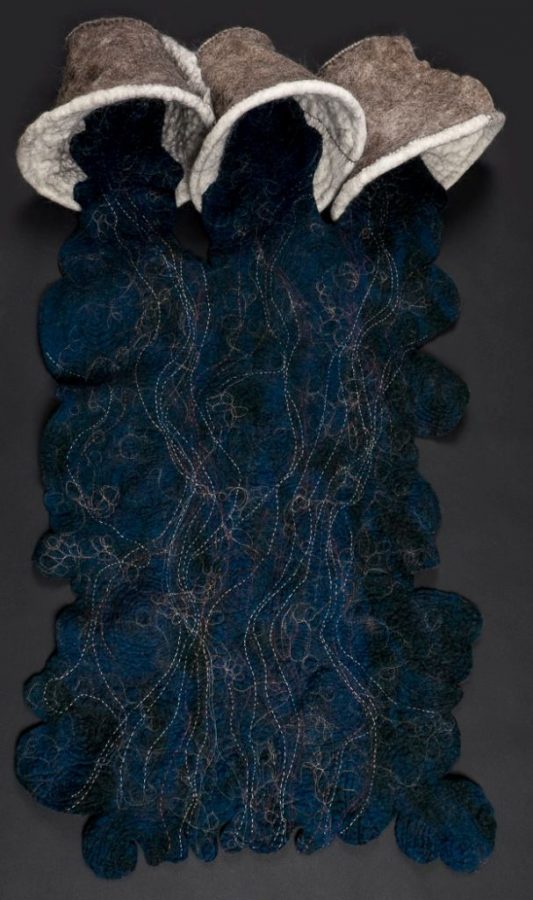Artists explore ‘Art of our Consumption’
Published February 6, 2015
Like many other people, artists are concerned about our changing environment. They possess the unique ability to visualize this change in extraordinary ways. The Art of Our Consumption exhibition at The Foundry Art Centre in St. Charles explores not only our impact on the environment, but also the throw-away and sustainable materials we use.
Faith Hagenhofer uses felt, a dry medium, to comment on a vital wet medium: water. Her 3’ x 5’ three-dimensional piece Flow is comprised of wool felt. Three upside-down buckets pour out water, dark blue and dark green mottled felt stitched with wavy and curling lines of contrasting thread. Flow calls us on our massive waste of water (washing cars, watering lawns), which may soon be the most precious resource on the planet.
Water is a common theme in this exhibition. Created by Karen Luckett, No More Fish is a 12” x 8” x 8” wire assemblage. A wooden base supports heavy chicken wire shaped into a trap with an open bottom. Around part of the trap winds a fist-sized bundle of discolored fishing line, as if no one fished here for a long time. Caught in the trap is the skull of an unidentified creature. Luckett used objects most of us would consider trash, to make a point about our treatment of the environment. The artist explains that the piece is a “prophecy of what is to come if we don’t stop polluting the water and consuming too much of our limited and valuable resources.”
Sandra Jane Heard also explores the concept of disrupted habitats with her 5’ x 4’ x 2’ piece Indigenous Expulsion. Made of wood, reeds, silk, linen, vintage pages of National Geographic, and re-appropriated chosen objects, it features a large white window frame with amber glass panes which supports 4 large (one- to two-foot high) alien entities with multiple insect-like legs, cone-shaped fiber bodies, and spear-like heads. A thin wooden slat extends out from the window like the plank on a pirate ship; at its end, two small polar bear figures bound to the slat by thread walk away from the entities. The aliens (representing people) take over the bears’ territory, causing them to abandon it. The thread has multiple meanings: it is a “preserving mechanism,” says the artist, a “capturing force,” and it demonstrates the “connectedness of all existence.” Heard’s piece “investigates the exploitation and consequences that arise when two spheres of existence collide…between mankind and nature.”
The Art of Our Consumption is on view at The Foundry Art Centre through February 13. The Foundry is located at 520 North Main Center in downtown St. Charles. Gallery hours are Tuesday – Thursday, 10:00 a.m. – 8:00 p.m.; Friday and Saturday, 10:00 a.m. – 5:00 p.m.; Sunday, 12:00 p.m. – 4:00 p.m.; and closed Mondays. For more information, call 636-255-0270 or visit www.foundryartcentre.org.















